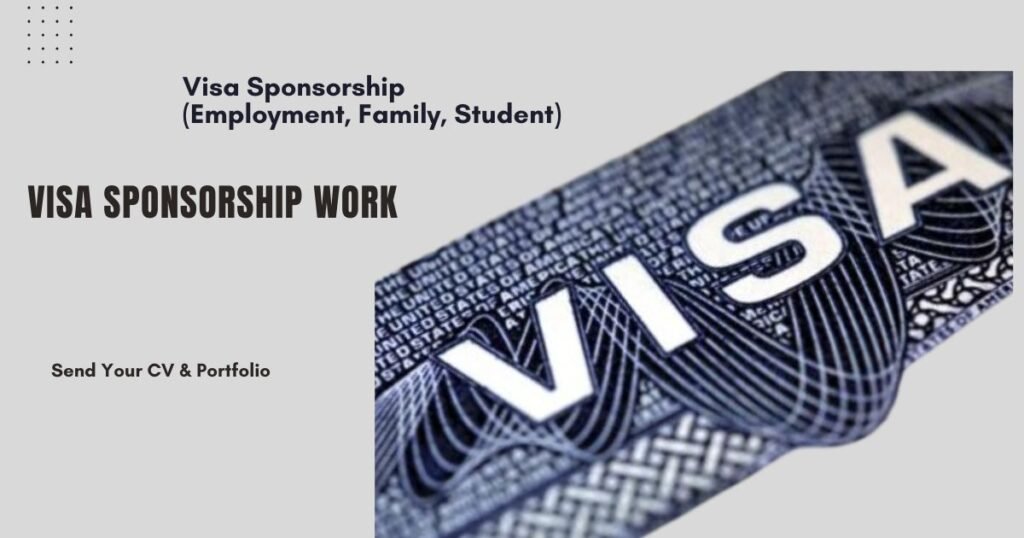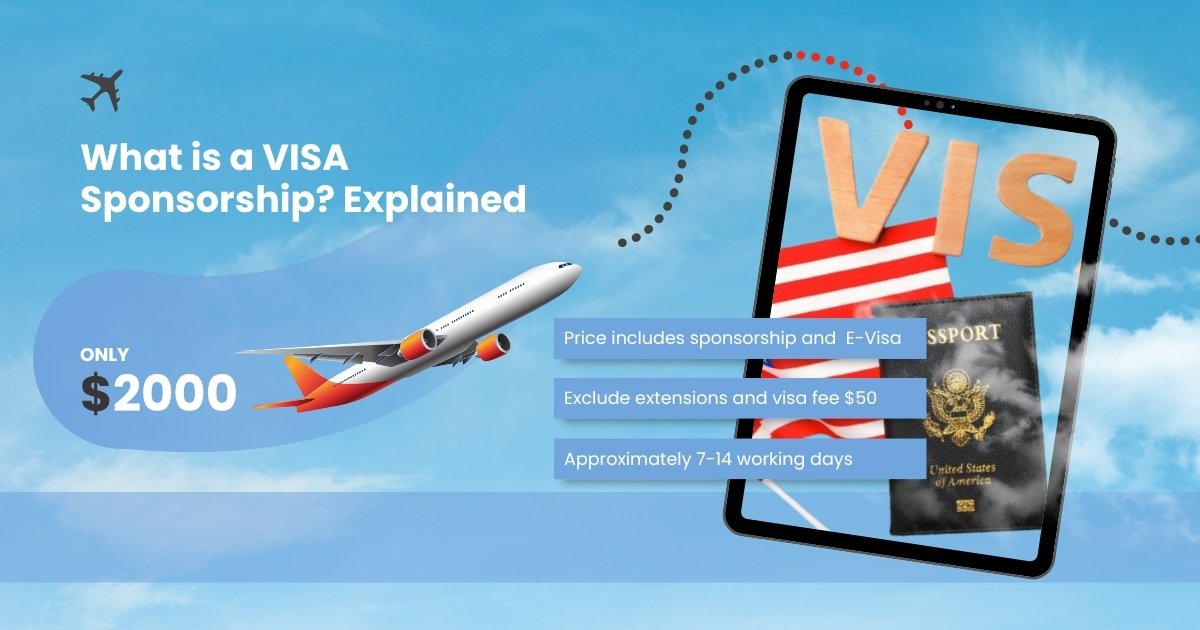What is VISA Sponsorship?
Visa Sponsorship is when a company, organization, or individual supports a foreign worker’s application to legally live and work in another country. In simple terms, it’s like a “work permit” that allows someone from abroad to move to a country for employment, study, or sometimes family purposes.
Why Do Employers Offer Visa Sponsorship?
- Fill critical skill gaps: Employers in IT, Engineering, and Healthcare Sponsor Visas because local talent isn’t always enough.
- Access global expertise: Sponsoring lets them attract top international professionals.
- Stay competitive, especially in fast-growing sectors like tech and biotech.
- Talent retention: Employers often extend long‑term or permanent positions to sponsored workers.

How Does Visa Sponsorship Work?
- The employer registers with the government as a licensed sponsor.
- They file a petition or sponsorship application on behalf of the candidate.
- The immigration agency reviews and approves if the legal conditions and job qualifications are met.
- An employee may apply for the visa and, once issued, can travel and begin working or studying.
Key Benefits of Visa Sponsorship for Foreign Workers
- Legal right to work/study in the destination country.
- Pathways to long‑term or permanent residency.
- Employer handles major visa paperwork and legal compliance.
- Access to benefits: salary, insurance, family accommodation, etc.
Types of Visa Sponsorship (Employment, Family, Student)
Employment sponsorship
- Used by companies to hire foreign workers—for example, H‑1B in the U.S., Skilled Worker Visa in the UK, LMIA‑based work visa in Canada.
Family sponsorship
- Citizens or permanent residents sponsor close relatives (e.g., spouses, parents) to join and reside legally.
Student sponsorship
- Universities or colleges act as sponsors, issuing documents (e.g., Form I‑20 in the U.S.) for student visas to enroll in degree or exchange programs.
Employer‑Sponsored Visas vs Self‑Sponsored Visas
- Employer-Sponsored Visas: The employer acts as the petitioner, typically for jobs, which require a job offer and compliance.
- Self‑Sponsored Visas: Individual petitions based on their credentials, like investor visas, extraordinary ability visas, or self‑employed entrepreneur visa categories.
Which Countries Offer Visa Sponsorship for Jobs?
| Country | Common Sponsorship Programs | Sectors Hiring Sponsored Workers |
| United States | H‑1B, EB‑2, EB‑3, TN (US‑Mexico‑Canada) | Tech, Healthcare, Engineering, Finance |
| Canada | Express Entry, LMIA‑based work permits | IT, trades, healthcare, hospitality |
| UK | Skilled Worker Visa (Tier 2), Global Talent | Finance, academia, and healthcare |
| Australia | Skilled Migration, Employer Nomination Scheme | Construction, engineering, and healthcare |
| Germany (EU) | EU Blue Card, Job Seeker Visa | IT, research, engineering |
What Employers Look for Before Sponsoring a Candidate
- Required education, qualifications, or experience for the job.
- Proof of market rate salary or ability to pay legal wages.
- Ability to demonstrate that no qualified domestic candidate fits.
- Clean immigration and criminal record, professional standing.
Legal Requirements for Visa Sponsorship
- The company must be a licensed sponsor (varies by country).
- Must comply with labor regulations and wage requirements.
- Must submit legal forms: e.g., Labor Condition Application, Immigration petition forms.
- Maintain record‑keeping, reporting for audits.
Documents Needed for a Visa Sponsorship Application
- Job offer letter specifying salary and responsibilities.
- Employer’s sponsorship license certificate or confirmation.
- Candidate’s passport, educational credentials, certificates, CV/resume.
- Police clearance, medical exam results (where required).
- Completed immigration forms & employer letters.
Who Qualifies for Visa Sponsorship?
- Professionals with required academic credentials or specialized experience.
- International students with an admission offer + sponsorship from the institution.
- Skilled workers in short‑supply occupations.
- Close family members of permanent residents or citizens (for family sponsorship).
Difference Between Temporary and Permanent Visa Sponsorship
- Temporary Visa Sponsorship: Time‑limited work or study permits—e.g., H‑1B (up to 6 years), student visa valid for program duration.
- Permanent Visa Sponsorship: Employer eventually supports a green card/permanent residence petition (like EB‑2/EB‑3 in the U.S.) or equivalent in other countries.
How to Find Companies That Sponsor Visas
- Use LinkedIn and search with filters like “visa sponsorship”, “H‑1B sponsorship”
- Explore MyVisaJobs and H1Bdata.info for U.S. employer sponsorship history,y.
- Use region‑specific platforms: Job Bank (Canada), SEEK (Australia), EURES (EU).
- Google site‑search job boards: site:boards.greenhouse.io “visa sponsorship” finds listings from startups and companies directly.
Best Job Portals for Visa Sponsorship Opportunities
- LinkedIn Jobs, Indeed, and Glassdoor all allow a “visa sponsorship” filter or query.
- Niche platforms: SponsorshipVisaJobs, VisaJobs, Workabroad, MyVisaJobs for targeted sponsorship listings.
Red Flags to Avoid in Visa Sponsorship Scams
- Employers or recruiters asking for up‑front fees or payment.
- Unlicensed companies claiming they’ll guarantee a visa.
- Offers with vague job descriptions and no official paperwork.
- Requests to share sensitive documents prematurely (passport, bank details).
Pros and Cons of Accepting a Sponsored Job Offer
Pros:
- Legal right to live and work abroad.
- Employer-supported paperwork and fees.
- Often leads to long‑term residency.
Cons:
- Terms tied to the employer—limited mobility.
- Dependence on the employer for visa renewal.
- Potential delays and uncertainty (e.g., lottery-based H‑1B).
- Possible exploitation in poorly regulated sectors if the employer is unscrupulous.
FAQ
Is visa sponsorship free for the worker?
Usually, most legal fees and paperwork are paid by the sponsoring employer or institution, not the applicant. Applicants occasionally pay the visa application or biometric fees themselves. Always confirm with the employer what costs you are responsible for.
Do countries offer visa sponsorship jobs?
Countries with structured employer sponsorship systems include the United States (H‑1B, EB‑3), Canada (LMIA, Express Entry), the UK (Skilled Worker visa), Australia (Employer‑Nomination Scheme), and various EU states offering Blue Card or work-permit-based sponsorship.How long does the visa sponsorship process take?
It varies by country and visa type. For U.S. H‑1B cap petitions, the filing window opens in April, the lottery results are by June, and visa issuance by autumn. Skilled Worker visas in the UK typically take 8–12 weeks from application. Student sponsorship (e.g., U.S. F‑1) can take 2–4 months, including admission and consular interview. Always check official timelines for your destination country.

